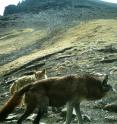Critically Endangered and ancient Himalayan wolf needs global conservation attention
Although the Himalayan wolf is visibly distinct from its European cousin, its current distribution has mostly been a matter of assumption, rather than evident truth. The most ancient wolf lineage, known to science, has been listed as Critically Endangered in the National Red List. Now, an international research team, led by Madhu Chetri, graduate student at the Hedmark University of Applied Sciences, Norway, report the wolf from Nepal's largest protected area, thus confirming its existence in the country. Their findings are published in the open access journal ZooKeys.
When compared to the European wolf, this one stands out with its smaller size, unusually longer muzzle and stumpy legs. Another clearly distinctive feature is the white colouration around the throat, chest, belly and inner part of the limbs. On the other hand, its characteristic woolly body fur has given the subspecies the common name 'woolly wolf'.
However, the distinctiveness of the Himalayan wolf is far more than skin-deep. The authors note that recent studies have already revealed that these wolves have split as a separate branch within the 'tree of life' so long ago that they are divergent from the whole globally distributed wolf-dog clade. Having undergone such an isolated evolution, the Himalayan wolf is considered of particular conservation concern.
However, the populations are still suffering heavy mortality. As a part of their research, the authors conducted both formal and informal interviews with about four hundred local herders, livestock owners, nomads and village elite to find out more about the status of the human-wolf conflict, as well as their attitudes and perceptions. As a result, they found out that the wolves are considered to pose a threat for the local livelihoods. They were persecuted and killed as a means of depredation.
"These genetically distinct Himalayan wolves deserve special conservation attention, at the same time that the conservation of this species in a context of human-wildlife conflict is challenging," conclude the scientists. "A species action plan needs be formulated that develops mechanisms to minimize conflict, and strategies for motivating local communities towards wolf conservation."
Original source:
Chetri M, Jhala YV, Jnawali SR, Subedi N, Dhakal M, Yumnam B (2016) Ancient Himalayan wolf (Canis lupus chanco) lineage in Upper Mustang of the Annapurna Conservation Area, Nepal. ZooKeys 582: 143-156. doi: 10.3897/zookeys.582.5966
Source: Pensoft Publishers
Other sources
- Woolly Wolf Spotted in Nepal Is Likely a New Speciesfrom National GeographicThu, 28 Apr 2016, 18:20:43 UTC
- Critically endangered and ancient Himalayan wolf needs global conservation attentionfrom Science DailyTue, 26 Apr 2016, 3:10:51 UTC
- Study: Himalayan wolf in desperate need of protectionsfrom UPIMon, 25 Apr 2016, 18:00:49 UTC
- Critically endangered and ancient Himalayan wolf needs global conservation attentionfrom PhysorgMon, 25 Apr 2016, 15:21:03 UTC
